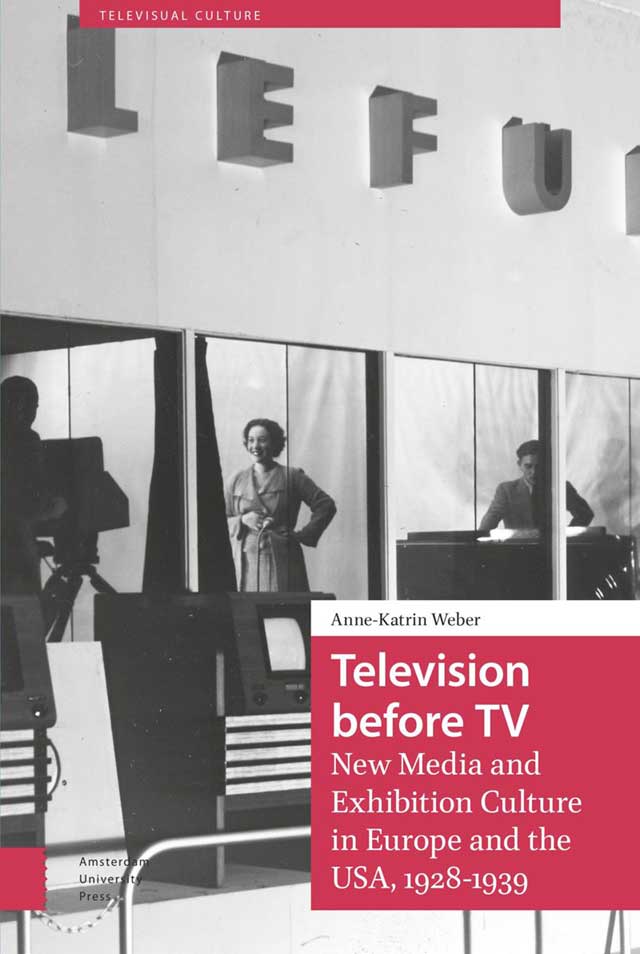Just as research on early television history has increased in recent years, so have the number of titles which help to expand our knowledge of how and why television became to be such a presence in our lives. Often counteracting the notion that somehow television simply ‘appeared’ in our homes, recent titles by Doron Galili (2020) and Jamie Medhurst (2022) have paved the way for a robustly researched discussion of the history of television before established television broadcasts themselves. Anne-Katrin Weber here sets out to provide detail of the important history of how television as a domestic concept as well as a commodity for mass audiences was promoted, publicised, and demonstrated to the public.
Weber uses a range of archival research focusing on inter-war public displays of television to these large and ‘first’ audiences (p.28) from countries that were key in the development of early television – namely Britain, Germany, and the United States - to clarify the entangled histories of interwar television and its symbolic, cultural, political, and social implications. Weber demonstrates how these early exhibitions initially drew, and eventually fixed, perceptions of what television would become in domestic settings after World War II. By outlining how television was staged as an attraction at exhibitions, Weber also plots a framework to aid understanding of what happened after television became accepted as a domestic medium, connecting her research to various other strands of television historical research such as that examining gender, class, technology, audience, advertising, and entertainment. Ultimately, Weber presents a vivid resource which will prove an invaluable context for scholars of media history, material culture and advertising in the years to come.
Weber structures her book engagingly by weaving information from all three nations across several key themes which have emerged from her research, following principles of media archaeology to build, present and analyse the archival materials. An introductory chapter links the invention of televisions as material objects with the interwar public displays as attractions and spectacles in themselves. Chapter One places television as an industry and as an object of consumer culture in a context that would determine its subsequent presentation. In Chapter Two, Weber argues that exhibition spaces made televisions ‘electric attributes’ visible and comprehensible to visitors (p.94), with the exhibition floors themselves becoming a visual and sensual spectacle as the first introduction to television audiences would experience (p.105). In Chapter Three, Weber demonstrates that television was wisely promoted as a ‘modern miracle’ (p.114) which ‘nourished a culture of astonishment’ not through spectacular content, but public display (p.137).
Chapter Four examines how the case study countries sought to establish a transnational context and identity for their own television services and products while recognising the shared efforts to push forward with the technology, the publicity, and the drive to generate a public desire to own television sets. Chapters Five and Six further explore the domestication of television from outside the home, tackling the complexities involved in showcasing a private, domestic medium such as television through promotion in public spaces (p.255). These chapter also examine the connected gendering of television on and off the screen, through the establishment of television sets as desirable ‘feminine objects’, as well as respectable objects for family entertainment (p.313). Weber provides a conclusive epilogue collecting experiments in television past and present which led to a normalisation of television as a domestic medium (p.348).
The strength of Weber’s argument lies in the central notion that to explore ‘Television before (broadcast) TV’ a wide range of interconnected research methodologies need to be employed. While other researchers have chosen to look primarily at institutional records, aspects of material culture, technological developments, or accounts of those involved, Weber makes a positive case for connecting all of these and more together. Her central thesis is that images, advertisements, and illustrative publications from the time are critical to understand that ‘television before TV was not without content’ (p.348). Instead, the rich information and associated images presented highlight the commodification of television as a domestic consumer good (p.314), a symbol of harmonious family life (ibid.) and, interestingly, as a double commodification, being an object for purchase and an advertising feature (p.323) which often featured images of women operating the sets (ibid). The book itself contains one hundred images, used deliberately to underline the visual medium of television before TV (p.38).
Weber introduces some key and unexpected ideas which will be useful to a range of television history scholars. She cleverly illustrates the concept of participation of ‘ordinary’ people and audience participation in early exhibition broadcasts. People were encouraged to ‘come and be televised’ (p.173) at Radio Olympia by the BBC if they felt they had interesting stories to tell. This performed the dual function of establishing familiarised audiences for the television broadcasters and at the same time creating ‘free’ content to fill airtime (p.176). Weber introduces the alternative idea that exhibition spaces, and indeed department stores (p.265), were used to trial and demonstrate different but similar technology, television sets and formats (p.196) adding greatly to the established histories of ‘testing’ which are ordinarily presented from an institutional perspective, such as the BBCs trials of Marconi and Baird systems.
Television Before TV is both well researched and enjoyable to read, with clear original source information and a fresh methodology invaluable to any social, technological and media historian interested in developing their own frameworks to rethink and illustrate social formations. Weber does this successfully with the coining of the term ‘television before TV’, without contradicting existing research. Her ability to connect her thoughts, ideas, and evidence to the work of many other key works of media history is to be admired and hopefully replicated.
Competing Interests
The author has no competing interests to declare.
References
Galili, D 2020 Seeing By Electricity: the Emergence of Television 1878–1939 Durham: Duke University Press. DOI: http://doi.org/10.1215/9781478009221
Medhurst, J 2022 The Early Years of Television and the BBC Edinburgh: Edinburgh University Press. DOI: http://doi.org/10.1515/9781399504126
